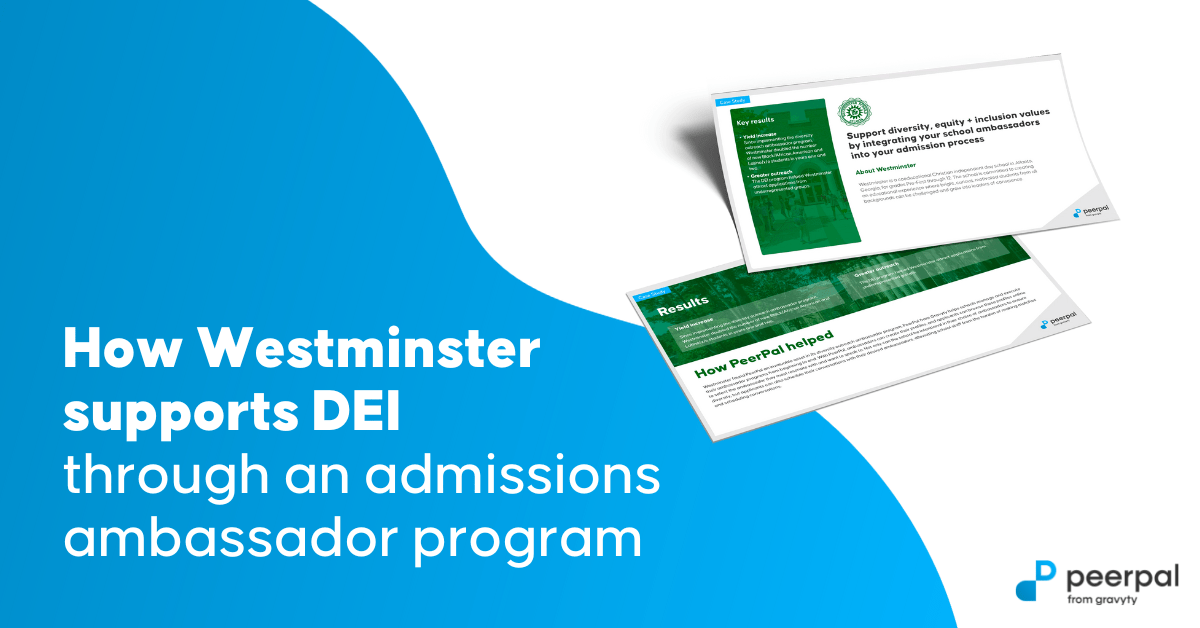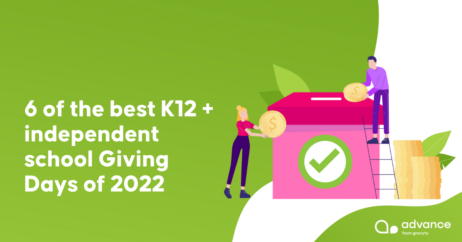How Westminster supports diversity in admissions with an ambassador program

About Westminster
Westminster is a coeducational Christian independent day school in Atlanta, Georgia, for grades Pre-First through 12. The school is committed to creating an educational experience where bright, curious, motivated students from all backgrounds can be challenged and grow into leaders of conscience.
Get the case study
Support diversity, equity + inclusion values by integrating school ambassadors into your admission process
The commitment to diversity, equity and inclusion at Westminster
As a school that has always been committed to helping all families feel welcome no matter where they come from, Westminster has long been focused on DEI. After national calls to change attitudes and policies in schools toward racial equity, Westminster’s board of trustees and senior leadership announced a series of action steps to help the school renew its commitment to inclusivity and to help foster a culture where every person in the community is celebrated.
If you’re looking for ways to strengthen diversity in admissions and within the culture at your school, the following tips inspired by Westminster’s diversity outreach ambassador program will help you.
Analyze your applicant population
Westminster is an independent school in the Atlanta area. Each year, Westminster’s Office of Admissions and Enrollment Management leads the School in seeking a diverse pool of applicants with a broad range of strengths and interests.
Their goal is to ensure a dynamic and vibrant student body comprised of bright, motivated children who thrive on challenges. Specifically, they sought to ensure their school reflects their local community, ultimately fulfilling the School’s mission.
Ask for help from industry leaders and implement tools that provide data and support
Analyzing your applicant population and comparing it to local demographics might sound daunting, but don’t worry if you haven’t got a team of data scientists on hand. Schools can access several readily-accessible tools to help with admissions-related policies. There are also organizations that help schools define and achieve their enrollment aims.
Westminster is a member school of the Enrollment Management Association (EMA)—a nonprofit association dedicated to helping schools perform enrollment in a better and more equitable way. EMA serves more than 13,000 US schools, offering advisory services and software tools that schools can use to analyze their enrollment services. Westminster attends its annual professional development conference to gather and share ideas with colleagues in the industry.
Westminster used the National Association of Independent Schools‘ “Market View” tool, which synthesizes various data points, including census numbers, American Community Survey Data, and Public Use Microdata Survey, about the population within a 30-mile radius of the school. The information helped the school gather hard facts about their catchment areas to decide how inclusive their services were.
Identify underrepresented groups
Once you have gathered the data, it will be clear whether there are any underrepresented groups to which you should reach out. For example, Westminster realized that the local Atlanta population had grown and changed over the lifetime of the school.
Today, non-whites, particularly Black/African American and multiracial students, now make up a majority of school-aged students within a 30-minute drive of the school’s zip code. The Office of Admissions and Enrollment Management identified that neither their current school population mirrored the racial and ethnic diversity of their locality and thus identified a significant opportunity to improve the reach of their services.
Get the case study
Support diversity, equity + inclusion values by integrating school ambassadors into your admission process
Define your approach to enrollment management and diversity in admissions strategy
Have you adopted an “enrollment management” or an “admissions approach”? These practical terms, discussed by Hans Mundahl (Senior Director of Professional Development at EMA), can help you evaluate how well your school creates an inclusive and happy environment for all populations.
Admissions approach—This focuses on the numbers and how many applicants your school attracts, without necessarily delving into who they are and how comfortable different groups feel in your school.
Enrollment management approach—This approach focuses more on how it feels to be in your school. It considers the different groups that make up the school population and how happy these groups are made to feel. Where people leave or express dissatisfaction, the school tries to uncover where they have been remiss in serving the population represented by the leaver.
Adapt personalized messaging to attract new groups
If you’ve identified groups you’re failing to attract, one of the first places you need to look is your messaging. At any point along your admissions funnel, you may inadvertently alienate a group, so it’s essential to consider the entire process from beginning to end.
For example, Westminster noticed that Black and LatinX families were often starting but not completing their applications. When members of these groups completed an application and were accepted, they would often reject the spot. This prompted the school to dive deeply into why this was happening and take steps to review and personalize its messaging.
Use ambassadors that represent the population you want to support and include
Parent ambassadors are among the most powerful advocates any school has, so use this resource wisely and carefully. Parents are talking about your school anyway, and prospective families will approach parents they know in the local community to ask their questions. If you have an enthusiastic and willing parent body, it makes sense to recruit these people as official mouthpieces for your school. That way, you have more control over a conversation that will happen, whether you oversee it or not.
When selecting school ambassadors, think of the community you are hoping to attract and ensure that your choice of ambassadors reflects this fully. For example, a parent from a Latin-American background may be interested in learning more about the experiences of a student from a similar ethnic background.
The same may be true of someone entering the school on a sports scholarship. Make sure everyone you want to attract can find some commonality in your parent ambassador group.
Create an onboarding and training program for your ambassadors
No, you don’t need to run a year-long ambassador training course, but you do need to provide your ambassadors with some guidance. Westminster identified that many ambassadors were nervous about saying the “wrong” thing. They would approach the school’s admissions office and ask, “What should I say if someone asks about x?”
The most important thing to convey to all your parent ambassadors is that authenticity trumps all! Their job is to share their experiences at the school as openly and truthfully as they can, and nothing else. The office can provide all the technical details. Give them free reign to share their stories and anecdotes about how they and their family are made to feel in the broader school. This will help those from varied populations understand what it truly feels like to be a member of the school’s community.
Some schools may notice that they are failing to attract one particular group and design an ambassador program around this group specifically. This is a legitimate approach for those who are generally happy with their application process but feel one underrepresented group exists.
Make sure to follow the industry changes closely
Increasing diversity in admissions and student populations is a fluid process; things change, and you should be prepared to change too. Local demographics can shift, the needs of your population can shift, and unknown factors can affect your applications.
Keep the channels of communication open at all times. Talk to your community. Talk to representatives of different groups. Find out whether you’re addressing people’s needs or not. Most importantly, ask your community for suggestions on how you can improve your services to make them feel more welcome in your school.
How PeerPal from Gravyty helped Westminster improve diversity in admissions with an ambassador program
Westminster found PeerPal an invaluable asset in its diversity outreach ambassador program. PeerPal from Gravyty helps schools manage and execute their ambassador programs from beginning to end. With PeerPal, ambassadors can create their profiles, and applicants can browse these profiles online to select the ambassador they most resonate with and want to speak to.
Not only can the school be intentional in their choice of ambassadors to ensure diversity, but applicants can also schedule their conversations with their desired ambassadors, alleviating school staff from the burden of making matches and scheduling conversations.
See how PeerPal from Gravyty helps you amplify your word-of-mouth marketing while supporting your organization’s diversity, equity and inclusion initiatives. Get a demo.




